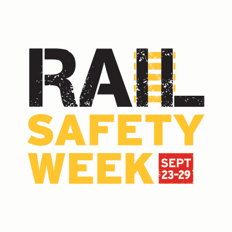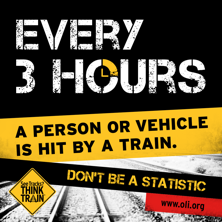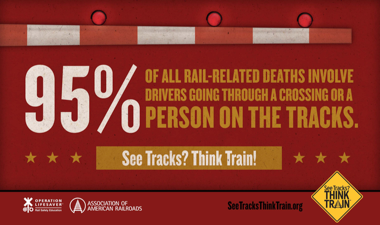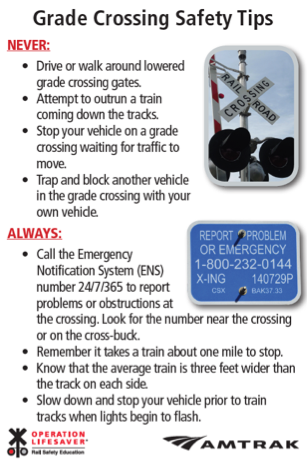News | Rail Safety Week 2018
Stop the VideoNews

Last month, Operation Lifesaver, a nonprofit public safety education and awareness organization dedicated to reducing collisions, fatalities and injuries at highway-rail crossings and trespassing on or near railroad tracks, kicked off the second annual Railroad Safety Week (Sept. 23-29). Believe it or not, a person or vehicle is hit by a train about every three hours in the U.S. The goal of Rail Safety Week is to raise awareness, encourage rail safety education and empower the public to make smart decisions near railroad crossings.


Be sure to search the following hashtags #RailSafetyWeek and #STOPTrackTragedies to learn more about this year’s Rail Safety Week efforts, and check out the content shared below:
- It's #RailSafetyWeek -- let's help #STOPTrackTragedies across CA
- FACT: Trespassing on train tracks is the leading cause of rail-related death in North America. @olinational @GoRail
- It's #RailSafetyWeek! Learn more from @olinational & get some tips for staying safe around the tracks. http://bit.ly/2yBTOVs
- Never try to beat a train. The weight of a locomotive to your car = that of a car to a soda can. #USRailSafetyWeek https://vimeo.com/129562719
- Here's a tip for #RailSafetyWeek -- this sign could save your life at a crossing. #seetracksthinktrainhttps://vimeo.com/222729263
- #RailSafetyWeek tip via @olinational: ALWAYS expect a train. Here are some more #STOPTrackTragedies tips & facts: http://bit.ly/2wh9QCI
- Remember -- during @olinational's #RailSafetyWeek & every day -- no photo is worth the risk. #STOPtracktragedieshttps://vimeo.com/146932433
- A train can extend 3 feet or more beyond the steel rail -- no #selfie is every worth it. #RailSafetyWeek #STOPTrackTragedieshttps://vimeo.com/147888194
- Law enforcement partners are conducting "Operation Clear Track" at crossings in CA & across the U.S. today! #RailSafetyWeek #STOPTrackTragedies

5 Things You Didn’t Know About Rail Safety
1. There’s an app for first responders
Thousands of first responders around the country have signed up for an innovative mobile app called AskRail. Launched in 2014 and recently updated with new features, the app is designed to prepare responders for a rail emergency in real time by providing immediate access to accurate, timely data about what type of hazardous materials a railcar is carrying. Updates unveiled this year include full integration of all North American Class I railroads, a map feature that provides isolation zones and points of interest and a French version. AskRail is included as part of standard emergency responder training from Class I railroads and can only be downloaded by qualified emergency responders who have completed rail emergency training. Railroads can also offer the app to known emergency responders along their routes.
2. Railroads are on the cutting-edge of safety
Trains have come a long way since the days of the Iron Horse. State-of-the-art technologies like big data, drones, and ultrasound technology are just a few of the innovations railroads use to advance rail safety. For example, while today’s inspection technology currently makes it possible for railroads to identify 90 percent of track defects before they lead to an incident, multidimensional ultrasonic technology, currently in testing, aims to identify the remaining 10 percent of track imperfections.
3. North American railroads partner to run the world’s leading rail research facility
Railroads jointly support the Transportation Technology Center, Inc., or TTCI, the world’s leading rail research and testing facility in Pueblo, Colorado. Many of rail’s new technologies — like the world’s first laser-based rail inspection system, or on-board computer systems that analyze track geometry — are developed and tested at TTCI.
Also housed at TTCI, the Security and Emergency Response Training Center (SERTC), trains thousands of first responders every year. SERTC is a collaboration between railroads and the FRA, where responders get hands-on experience with simulated hazmat incidents. The center also offers free, web-based training for those who cannot attend in person.
4. Positive Train Control is the largest and most complex safety system in the history of the railroad industry
In 2008, Congress mandated that railroads install Positive Train Control (PTC), a set of advanced technologies designed to automatically stop a train before certain incidents occur, across some 60,000 miles of the rail network. Implementation requires the deployment of hundreds of thousands of technology pieces, the precise geo-mapping of tens of thousands of miles of railroad right-of-way, as well as extensive training and testing to ensure systems are interoperable.
Despite the complexities and challenges of implementing PTC, freight railroads are on track to meet the deadline set out by Congress in 2015. The industry has invested upwards of $7.9 billion so far, spending about $100 million per month on continued development, testing and installation.
5. Private investments correlate with increased safety
Federal Railroad Administration (FRA) statistics announced earlier this year show that 2016 was the safest year on record for freight rail. Last year not only marked the lowest train accident rate on record, but likewise the lowest derailment rate, which declined 10 percent from 2015. These gains are not anomalies, but examples of how steady rail investment pays safety dividends. Since railroads were economically deregulated in 1980, they have spent over $630 billion and the train accident rate has decreased 79 percent

News Archive
- December (1)
- November (6)
- October (4)
- September (2)
- August (3)
- July (4)
- June (3)
- May (7)
- April (8)
- March (11)
- February (8)
- January (7)
- December (7)
- November (8)
- October (11)
- September (11)
- August (4)
- July (10)
- June (9)
- May (2)
- April (12)
- March (8)
- February (7)
- January (11)
- December (11)
- November (5)
- October (16)
- September (7)
- August (5)
- July (13)
- June (5)
- May (5)
- April (7)
- March (5)
- February (3)
- January (4)
- December (4)
- November (5)
- October (5)
- September (4)
- August (4)
- July (6)
- June (8)
- May (4)
- April (6)
- March (6)
- February (7)
- January (7)
- December (8)
- November (8)
- October (8)
- September (15)
- August (5)
- July (6)
- June (7)
- May (5)
- April (8)
- March (7)
- February (10)
- January (12)















